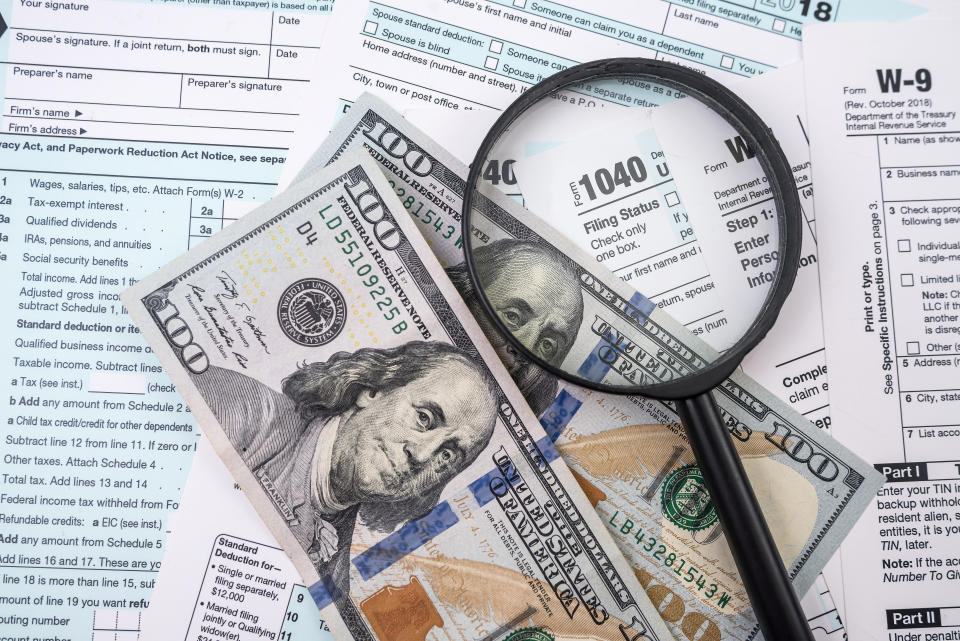You gathered the umpteen documents and forms. You did the math and checked it twice. You even filed your return early! Then the reward: a nice, plump refund from Uncle Sam landing directly in your bank account.
Here’s the bitter truth: Americans receiving large tax refunds would be better off getting a far smaller check from the IRS, experts say.
“Everyone loves a tax refund, even me,” Janet Holtzblatt, senior fellow at the Tax Policy Center, told Yahoo Finance. “Though I know better.”
More than three out of five taxpayers received tax refunds during filing season 2023, as the average amount climbed to nearly $3,200, according to IRS filing statistics. The average refund has been increasing steadily over the last decade and peaked in 2021 at $3,300, thanks to pandemic-related extra credits.
While everyone loves and welcomes a large tax refund that can reach half a month’s salary, experts cautioned that a big IRS check could mean you’re not putting your money in the right places, especially in today’s era of worsening household debt.
Despite a “culture” of anticipating big refunds at tax time, Holtzblatt said, “taxpayers actually would be better off trying to get their withholding correct and putting that money in a bank account and earning interest.”
Read more: Full coverage: Taxes 2024 — Everything you need to file your taxes on time
Credit card debt outgrows tax refunds
You receive a refund when the taxes you paid throughout the year through withholding total more than what you owe. The money is not a gift from the IRS. It was always yours.
“If the taxpayer has received large tax refunds in the past few years, this is an indication that they are withholding too much from their paycheck,” Michelle Su, a CPA and MBT (Master of Business Taxation) based in San Francisco, told Yahoo Finance. “They are essentially giving the government an interest-free loan, and putting less money in their own pockets.”
This especially rings true when consumers are strapped with some of the highest borrowing rates and debt balances in decades.
The average variable credit card APR reached 20.75% in February, a 38-year high, Bankrate reported. Nationwide credit card debt balances also peaked at $1.13 trillion toward the end of 2023, the Federal Reserve Bank of New York says — sending average credit card debt to $6,864 per cardholder.
Read more: Credit card interest and fees soar to $130 billion — but you don’t have to pay them
“It would be a better use of their money to decrease tax withholdings to pay off consumer debts or take the money to put in savings products for interest income,” Su said.
Tips for updating your tax withholdings
Many taxpayers are unaware that withholding can be changed anytime. You can increase or decrease paycheck withholdings by resubmitting a W-4 form (employee’s withholding certification) to your employer throughout the year, although experts suggest the earlier, the better.
“The best would be at the beginning of the year. But if [taxpayers] did later in a year, they could make more adjustments to make up the differences,” said Holtzblatt, “because life changes during the course of the year.”
The form can be downloaded from the IRS website or requested from the employer’s human resources department. Once you are ready to fill out the W-4, the remaining process is quick and simple, covering issues like filing status, number of dependents, income, and more, Su said. Once completed, the changes are reflected in your next paycheck.
Read more: How bonuses are taxed (and why it matters)


Beware of the underpayment penalty
If you’re going through significant life changes such as marriage, divorce, birth of a child, or death of a spouse, experts say to be careful when changing your tax withholdings.
Filing status and tax brackets often change along with life events, and the last thing you want is to get an underpayment penalty from the IRS. For instance, newly single divorcees often move to a more expensive tax bracket as single taxpayers than as spouses with married filing jointly status, so not updating withholding could mean owing more taxes by the end of the year.
Not paying enough during the year could be considered by the IRS as the government loaning you money — “and then you owe interest,” Holtzblatt said.
The IRS fines individuals for late or underpayment of taxes on income during the year. The general rule is taxpayers should be paying 90% of this year’s tax liability or 100% of last year’s tax liability (110% for taxpayers with AGI higher than $150K.) If you are unsure how much tax to pay, you should withhold 100% of what you owed in the previous filing season to avoid potential penalties.
“While it’s better not to get a refund,” said Holtzblatt, “you also don’t wanna get stuck in a position where you don’t have the money at hand to pay outstanding taxes and face a penalty charged with an interest.”
Rebecca Chen is a reporter for Yahoo Finance and previously worked as an investment tax certified public accountant (CPA).
Read the latest financial and business news from Yahoo Finance

















